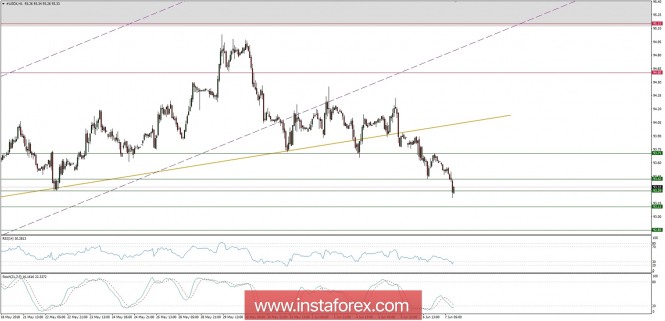
The Chinese department of trade confirmed that it is in talks with the US regarding the purchase of agricultural goods and energy. It was acknowledged that "specific" progress was made in the negotiations, details require "catching up" and the initiative is now on the US side. Mass media, on the other hand, speculates that Trump may adopt a "confrontational" tone after the last meeting of the G-7 finance ministers, the United States has been criticized by 6 other states for customs practices.
The dollar continues to sell against the basket of currencies. The issue of the global investor positioning for information from the FED meeting next week (June 12-13) is not yet taken up by the markets, although it seems that it is a good time, and the dollar has undergone a healthy correction in recent days. One can get the impression that the G-7 Summit in Canada is starting to become a problem, with the issue of US trade policy becoming the main topic. It is speculated that Trump may adopt a confrontational tone, which, of course, would not have been well received. Moreover, yesterday the European Commission announced that higher tariffs on selected American products could be introduced from July 1, which is a form of retaliation for not placing the EU on the list of countries excluded from higher duties on steel and aluminum. In conclusion, the G-7 summit may result in the escalation of mutual tensions, but it does not have to. This way or another it is an event worth to keep an eye on as it will have an impact on the financial markets.
The European session in the foreign exchange market is intensifying the pressure of USD sales. EUR/USD is the main driver of changes and pushes 1.1830, but also GBP / USD broke by 1.3470. Despite increases in European exchanges and growing yields on US debt (10Y 2.983%), USD / JPY is not able to stay above 110. The weakness of USD is less visible in relation to the currencies: CAD, NZD, AUD. Overall, therefore, everything seems to be a separate correction of the strength of the USD, rather than the impact of fluctuations in risk appetite or the impact of correlation with the debt market.
Let's now take a look at the US Dollar Index technical picture at the daily time frame. Historically, the dollar did not perform well in June. Even terribly to be specific. I the previous decade, the dollar index lost only harder in July and April. On average, it fell by 0.6% in June, moreover, the American currency lost in eight out of ten recent cases.
Currently, at the intraday hourly time frame, the market is still heading downward after the technical supports at the levels of 93.71 and 93.42 were violated. The next support is seen at the level of 93.11 and 92.85. Please notice the oversold market conditions and growing bullish divergence are indicating a short-term pull-back possibility, but the overall bias remains bearish.
